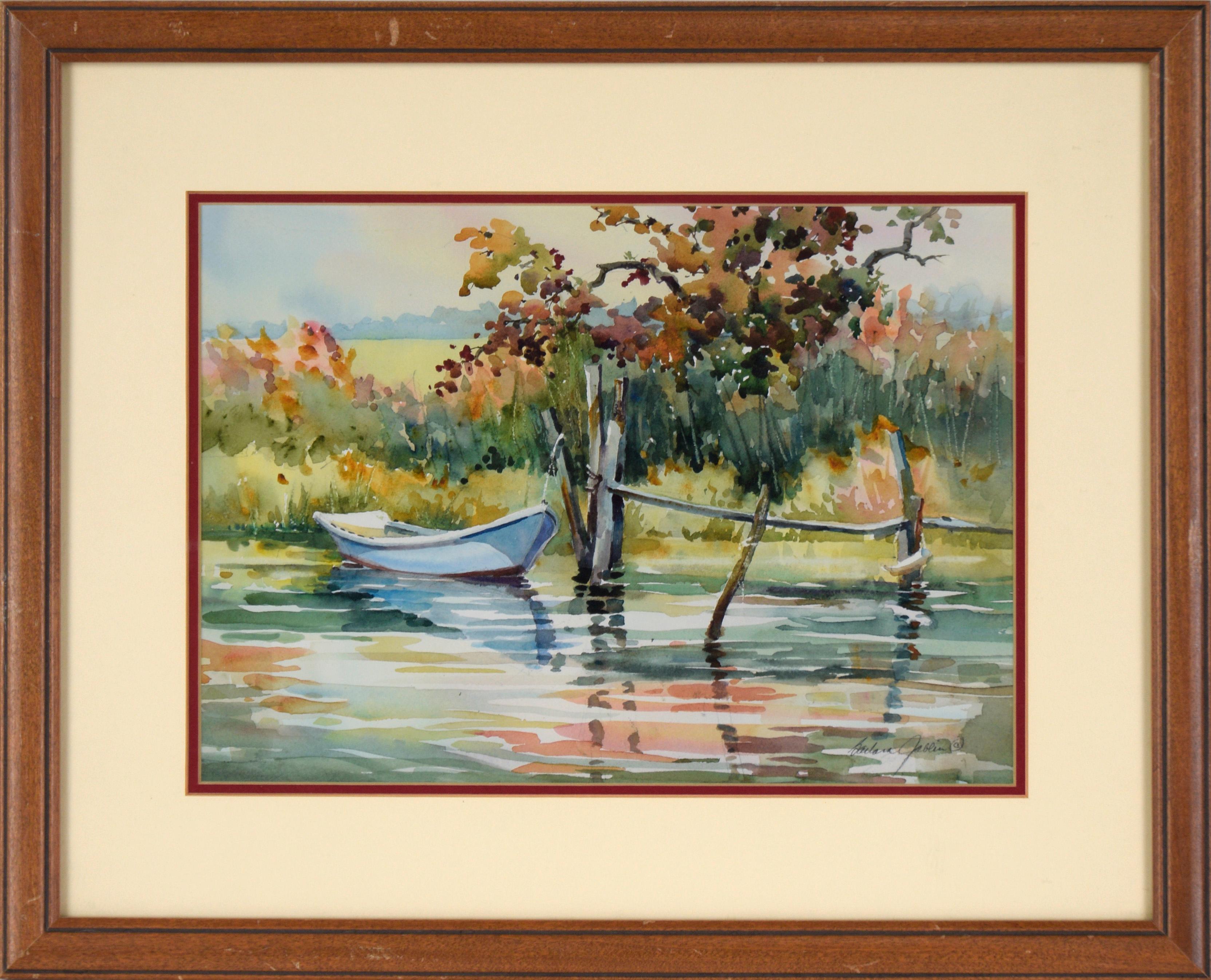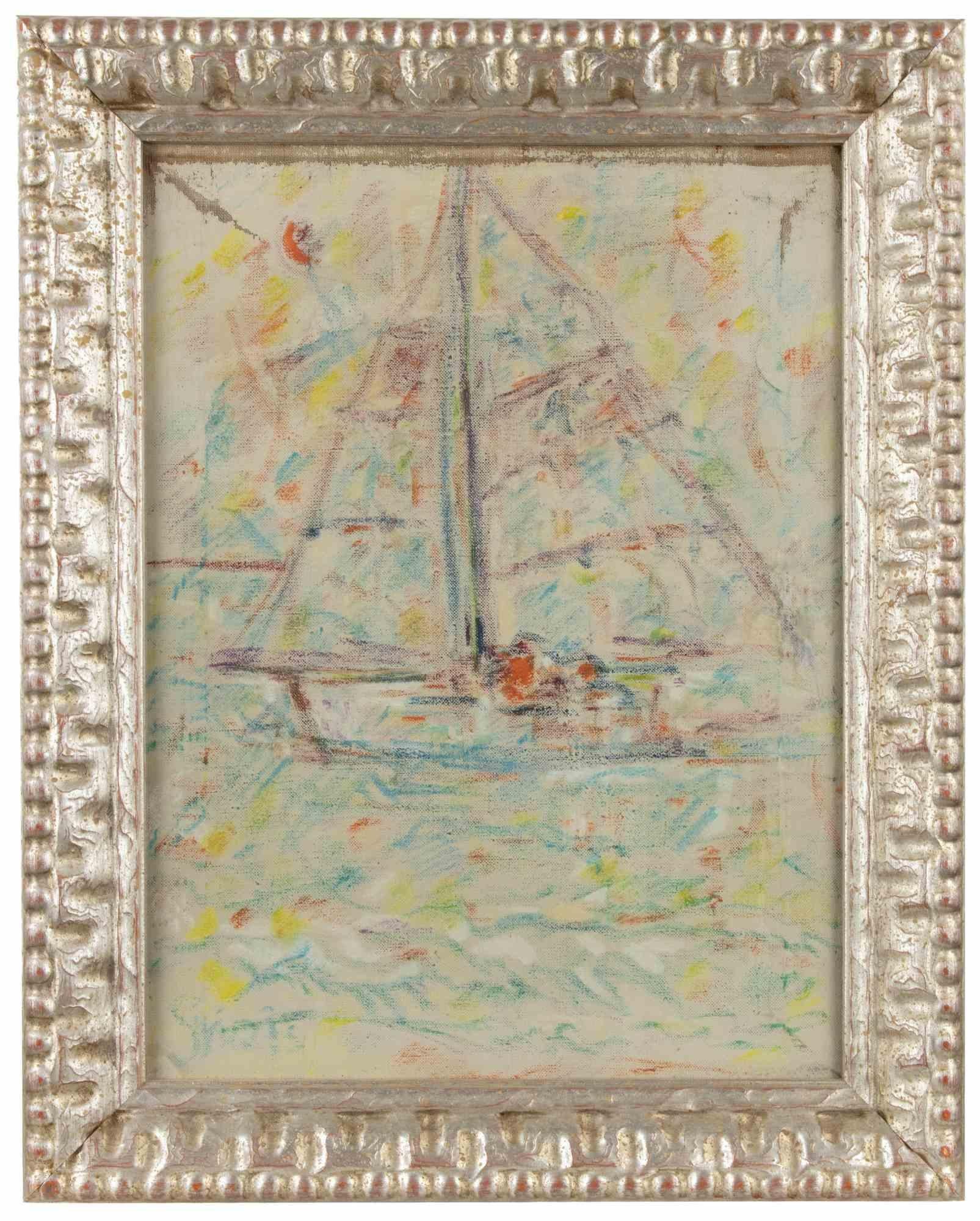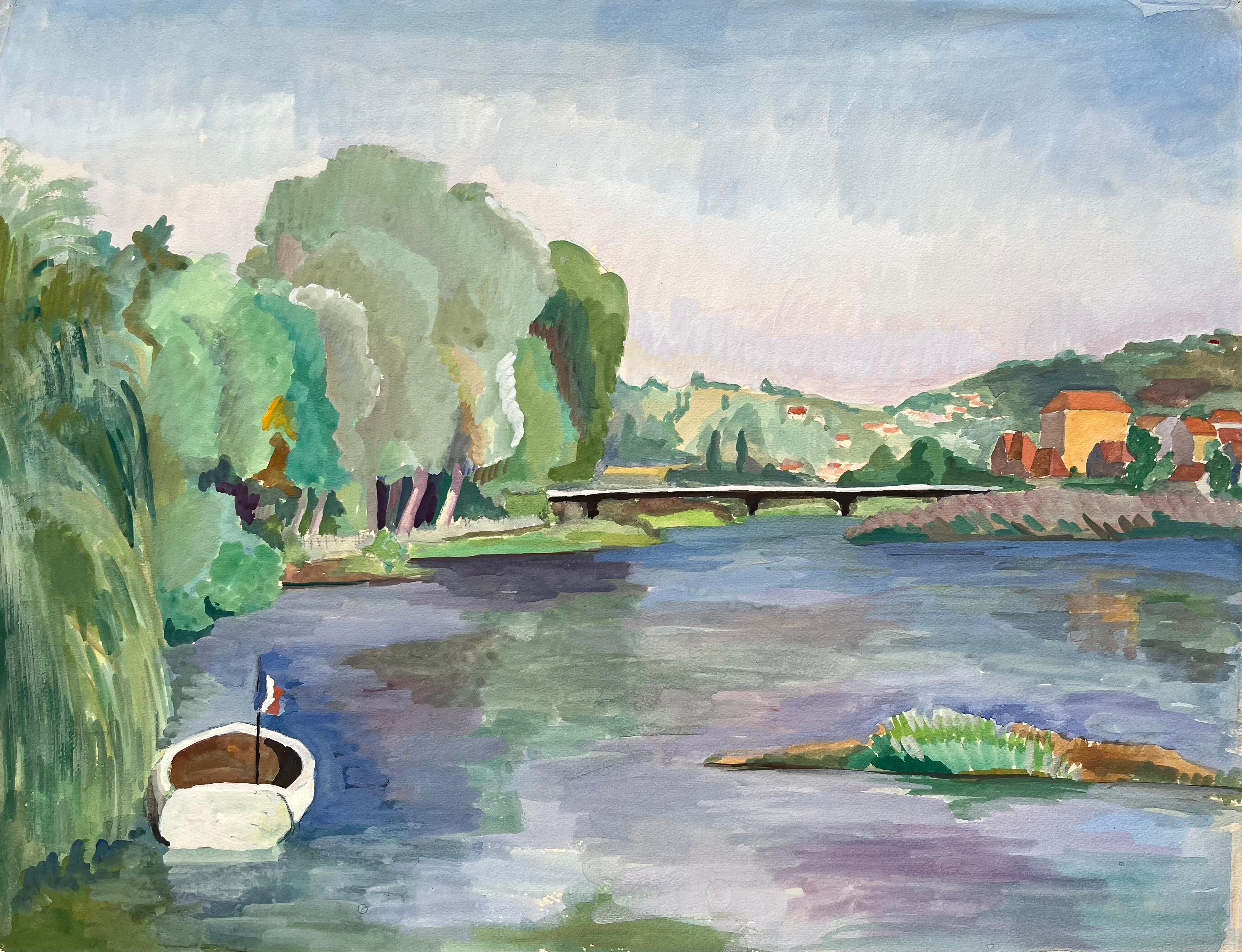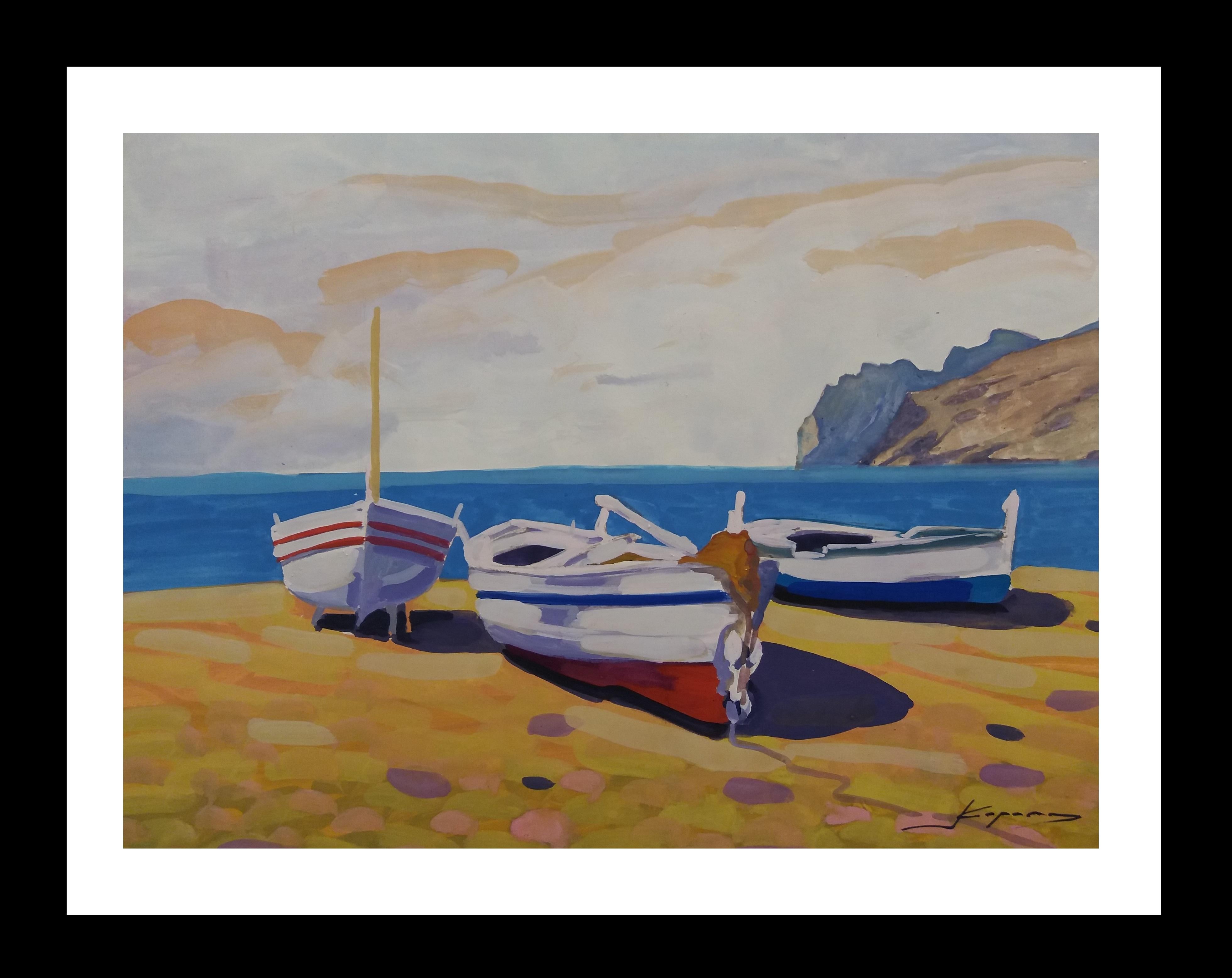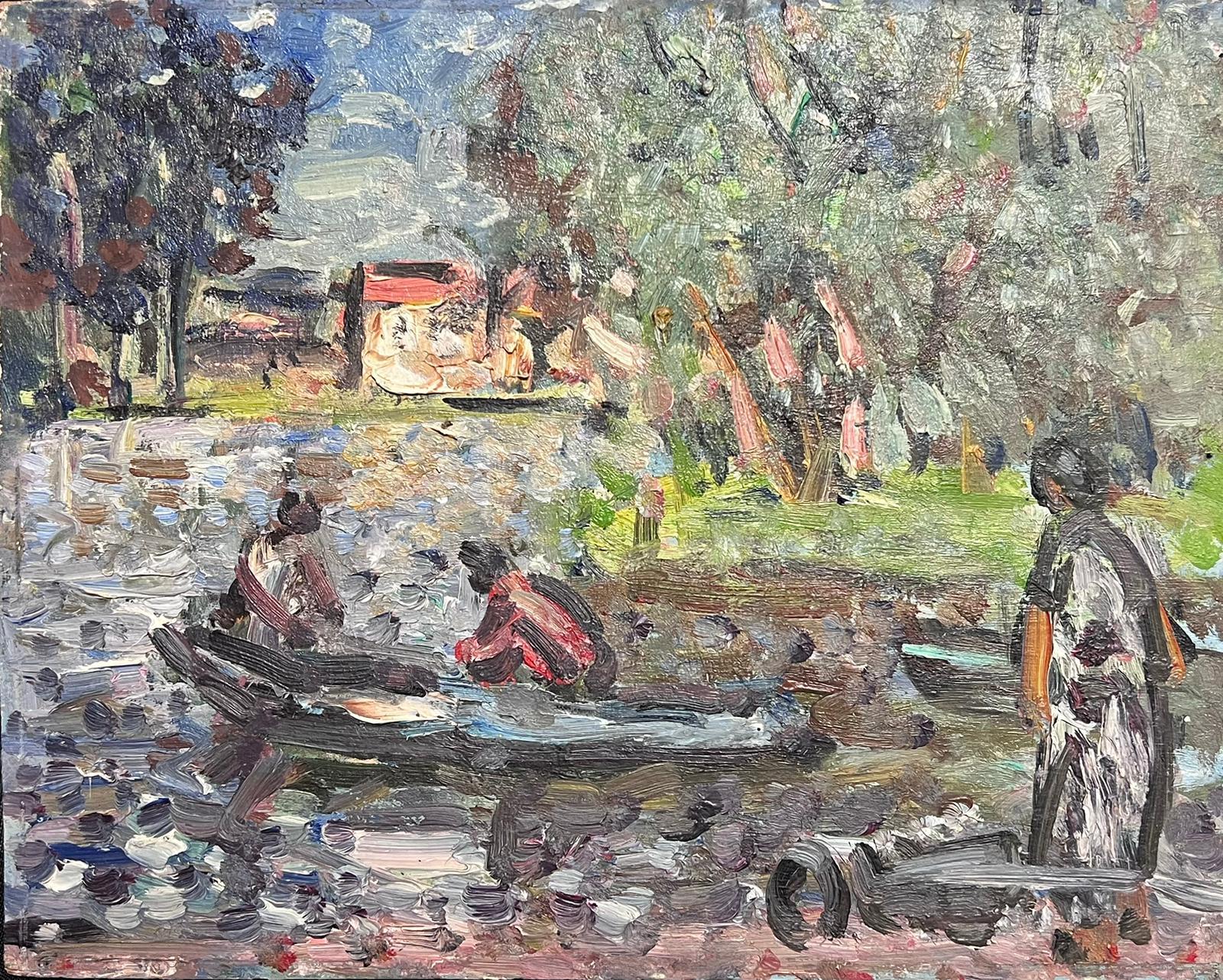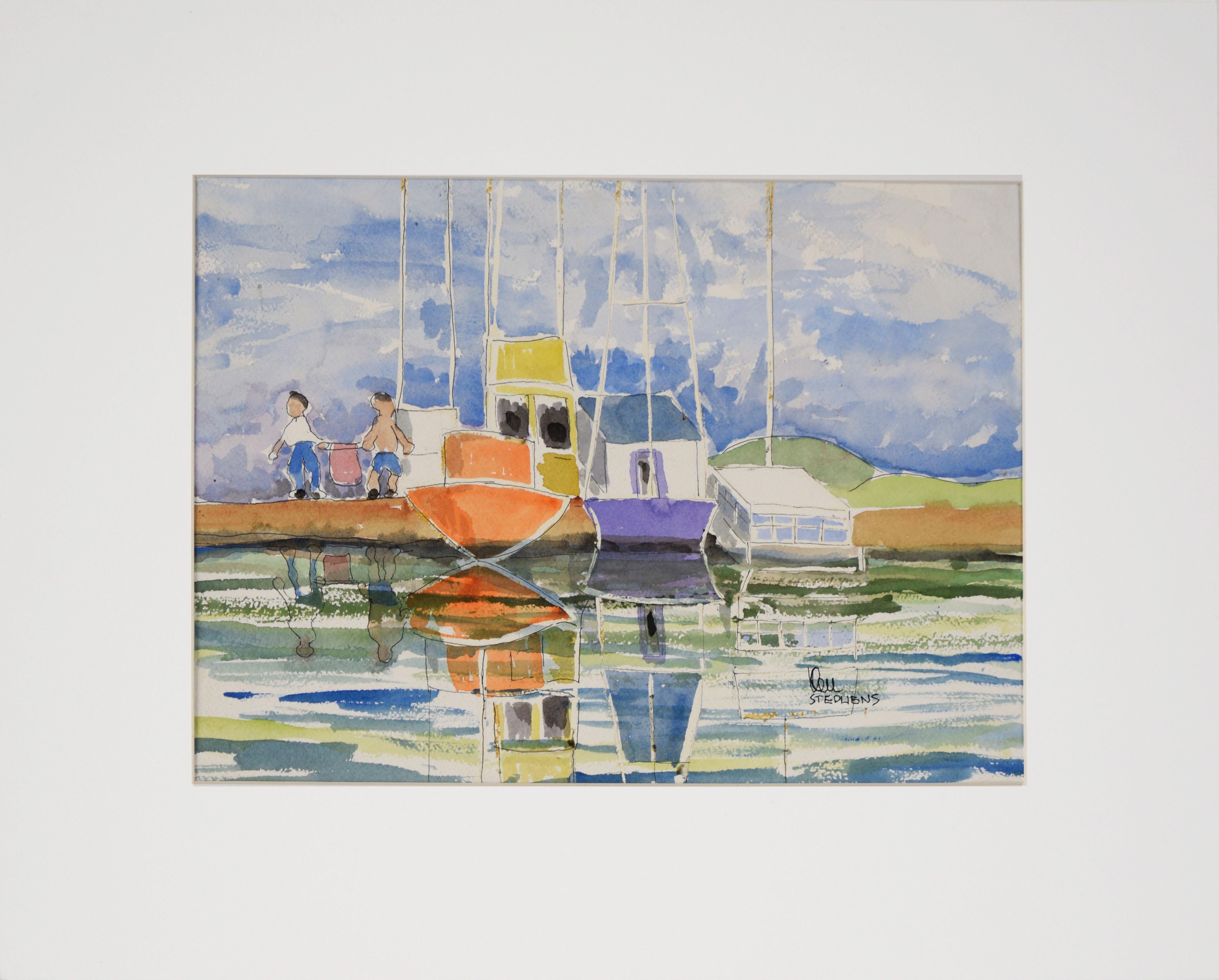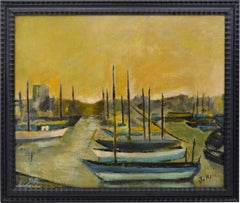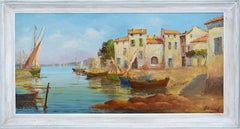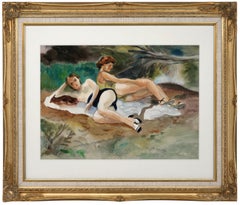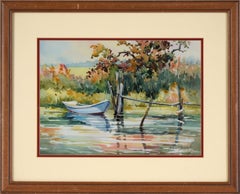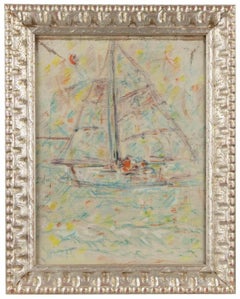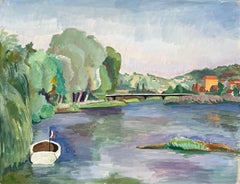Items Similar to "Boating on the Morin River"
Video Loading
Want more images or videos?
Request additional images or videos from the seller
1 of 14
André Dunoyer de Segonzac"Boating on the Morin River"1922-1924
1922-1924
$12,000
£8,981.82
€10,378.60
CA$16,640
A$18,638.94
CHF 9,690.18
MX$230,153.37
NOK 123,445.21
SEK 116,698.24
DKK 77,450.80
Shipping
Retrieving quote...The 1stDibs Promise:
Authenticity Guarantee,
Money-Back Guarantee,
24-Hour Cancellation
About the Item
Pen, ink, watercolor and wash on paper by André Dunoyer de Segonzac, France, 1922-1924. Boating on the Morin River. Measurements : with frame: 52.5x65x2 cm - 20.7x25.6x0.8 inches / without frame: 36.5x45 cm - 14.4x17.7 inches. Signed lower left "A. Dunoyer de Segonzac". Colors may vary slightly depending on your screen. The lighter band at the top and the bottom of the piece, visible in the first picture, is only due to the reflection in the protective glass. It does not exist. In its frame gilt with gold leaf and its protective glass.
André Dunoyer de Segonzac was born in Boussy-Saint-Antoine (Essonne) July 7, 1884. After his schooling at high school Henri IV, as early as 1900, he attends classes at the National School of Fine Arts in Paris in free listener where he will befriend Charles Dufresne. In 1903, he enters the private studio of Luc-Olivier Merson. In 1907, he studies with Jean-Paul Laurens and attends the La Palette and Colarossi academies in Montparnasse. He meets Luc-Albert Moreau and Jean-Louis Boussingault with whom he shares a studio. His first drawings are published in 1908 in The Great Review and The Witness. Nearly indifferent to contemporary aesthetic revolutions, Dunoyer de Segonzac undertakes, with Jean-Louis Boussingault and Luc-Albert Moreau, to revive Gustave Courbet's realism by performing still lifes, nudes, landscapes, in a thick paste and masonry . In one of his letters to the painter Maurice Boitel, he wrote in the 1950s: "I have not forgotten the heroic period of the independents - when we were grouped around Paul Signac, the charming and valiant Maximilien Luce - in these barracks where the living and authentic Art was grouped outside the academic formulas - or literary and systematic tendencies - which were to lead to this abstract aesthetic of which the painting dies. "
In 1908, he begins exhibiting at the Salon d'Automne and the Salon des Indépendants, with Paul Signac and Maximilien Luce. He befriends Apollinaire, Max Jacob, Raoul Dufy and Vlaminck. From this period, renting a house belonging to Signac, Dunoyer discovers the landscapes of Saint-Tropez, to which he will remain faithful and where he lived until the end of his life. He stays in Saint-Tropez only in the summer season. For the rest, he leads a real nomadic life, in search of the motive especially through the Île-de-France, the Grand Morin valley, Feucherolles, Chennevières-sur-Marne, Guyancourt, etc. "I also worked a lot on the banks of the Seine in Chatou, Bougival, Andrésy, Poissy and Triel that I particularly like, with its beautiful Gothic church that is reflected in the Seine and the high wooded hills that surround him", he will say.
In 1910, he knows fashion designer Paul Poiret and meets Max Jacob, Raoul Dufy and Vlaminck. From 1910 to 1914, he travels to Italy, Spain, North Africa, and is interested in sport and dance (drawings of Isadora Duncan's Russian Ballets, 1911, The Boxers, 1910). From 1914 to 1918, mobilized in the infantry, he makes the war hardly, before being assigned to camouflage. He performs many war drawings, valuable for their artistic and documentary value.
From 1919, he appears again in many exhibitions, including major Parisian salons. Nearly indifferent to contemporary aesthetic revolutions, Dunoyer de Segonzac undertakes, with Boussingault and Moreau, to revive Courbet's realism by performing still lifes, nudes, landscapes, in a thick and masonry paste. Enlisted in engraving by Jean Émile Laboureur, he makes nearly 1,600 brass plaques from 1919 to 1970. He was president of the Society of French painters-engravers.
In 1921, he meets Paul Valéry, Léon-Paul Fargue and Jean Cocteau. In 1928, he makes a trip to America where he met with great success. In 1930, he becomes friend with Derain. In 1933 he receiveds the Carnegie Foundation of Pittsburgh Award and in 1934 the Venice Biennale.
During the Occupation, in November 1941, he takes part in a "study trip" to Germany, organized by Arno Breker, accepting, like other artists of the most renowned, to visit the hotspots of German culture as well as artist workshops.
After the war, he is exhibited in the best galleries, in 1949-1950 at the Galerie Charpentier, in 1969 at the Galerie Vallotton, and in 1972 the Galerie Durand-Ruel.
Dunoyer de Segonzac has made sets and costumes for the theater, illustrated many literary works (Carco, Dorgeles, Tristan Bernard, Paul Morand, Jules Romains, etc.). He has also published extensively, including his etchings. Realist artist, he is the heir of Le Nain, Courbet and Millet. An independent painter, he never adhered to any of the great aesthetic movements of the beginning of the century. His style reflects the need for a new chromatic sobriety and a great graphic rigor; his palette is limited to dark shades, "Spartan", dominated mainly by ochres, lands, dark reds.
Dunoyer de Segonzac is an excellent draftsman. His graphics are characterized by the extreme precision of the line and by a great conciseness of form: Isadora Duncan (1909). In 1912, he adopted the technique of the pen, which is better suited to the effectiveness of his line. Its main sources of inspiration are the landscapes of the Île-de-France and the Midi represented in winter, a season whose stripping is perfectly suited to the graphic conciseness and monochromatism of the artist.
Watercolor is for him a painting in itself. An initial drawing in ink governs the whole composition and dominates the color: Roquebrune (1946), series of the Massif des Maures (1938, 1939 and 1947). Only the oil painting betrays an influence of cubism in the exceptional will of organization of the composition. It should be noted, however, a party of geometry that tempers the sensation. He shows a strong preference for massive forms, for a compact matter, and gives more importance to values than colors: The Canoeists (1914), Landscape in Saint-Tropez (1927), Still life with bread and wine (1936).
He is as an engraver and illustrator that he gives free rein to his sensibility: "My conception of engraving is quite similar to the one I have in drawing. It is a spontaneous and direct reaction to life, landscape, movement, light. The etching has been for me a complement of the drawing, it is the sister. His prints are incisive, expressive: a continuation of The Valley of Morin (1923), Beaches (1935), Tableau de la boxe (1921). Among his works as an illustrator, include the Cross of Wood Dorgelès (1921) and The Georgics of Virgil (1944-1947). A retrospective of his work as a painter and draftsman was presented in Paris in 1972 at the Galerie Durand-Ruel.
André Dunoyer de Segonzac died in Paris in 1974. He rests in St Tropez.
Awards and Recognition
1933: Carnegie Foundation of Pittsburgh Foundation Award
1934: prize of the Venice Biennale
1947: Member of the Royal Academy of London
1948: Associate member of the Royal Academy of Belgium
Exhibitions (selection)
1920: special exhibition, London
1938: Chicago
1939: London, Wildenstein Gallery
1949-1950: Charpentier Gallery, Paris - Basel
1951: Geneva Museum of Art and History
1959: Royal Academy of London
1969: Vallotton Gallery, Lausanne
1972: Durand-Ruel Gallery, Paris
Museums
The works by Dunoyer de Segonzac are present in the most prestigious museums of the world. Note the National Museum of Modern Art (Paris) where more than 70 works are listed (including thirty drawings). Among his emblematic works, we find oils on canvas such as Two nudes (ooc 1911), Bacchus (ooc 1933), Grand nude lying (ooc 1921), Lunch on the grass (1913), The bathers (1923), Nude lying with a black shoe (1922), The young ladies of the Marne (1923), and many others, as well as very beautiful watercolors such as The Gulf of Saint-Tropez in winter (1938), etc ... But also the Museum of Modern Art of the city of Paris with Lying Nude (hst 1919), Characters (hst 1920), Plowing in Provence (watercolor 1935), etc ... But also the Museum of Modern Art of New York, .. .
- Creator:André Dunoyer de Segonzac (1884-1974, French)
- Creation Year:1922-1924
- Dimensions:Height: 20.67 in (52.5 cm)Width: 25.6 in (65 cm)Depth: 0.79 in (2 cm)
- Medium:
- Movement & Style:
- Period:
- Condition:
- Gallery Location:Saint Amans des cots, FR
- Reference Number:1stDibs: LU1088216569142
About the Seller
5.0
Vetted Professional Seller
Every seller passes strict standards for authenticity and reliability
1stDibs seller since 2018
38 sales on 1stDibs
- ShippingRetrieving quote...Shipping from: Saint Amans des cots, France
- Return Policy
Authenticity Guarantee
In the unlikely event there’s an issue with an item’s authenticity, contact us within 1 year for a full refund. DetailsMoney-Back Guarantee
If your item is not as described, is damaged in transit, or does not arrive, contact us within 7 days for a full refund. Details24-Hour Cancellation
You have a 24-hour grace period in which to reconsider your purchase, with no questions asked.Vetted Professional Sellers
Our world-class sellers must adhere to strict standards for service and quality, maintaining the integrity of our listings.Price-Match Guarantee
If you find that a seller listed the same item for a lower price elsewhere, we’ll match it.Trusted Global Delivery
Our best-in-class carrier network provides specialized shipping options worldwide, including custom delivery.More From This Seller
View AllOil on Canvas by Jallais, Boats in Port, 1960s
Located in Saint Amans des cots, FR
Oil on canvas by Jallais, France, 1960s. Boats in port. In its pretty dark brown wooden frame. With frame: 68x58 cm - 26.8x22.8 inches, without frame: 61x50 cm - 24x19.7 inches. 12F ...
Category
1960s Post-Impressionist Figurative Paintings
Materials
Canvas, Oil
French Mediterranean Provencal Oil On Canvas, Boats in Martigues, 1940-1950s
By François Bernard
Located in Saint Amans des cots, FR
French mediterranean provencal painting. Oil on canvas by François Bernard, France, 1940-1950s. Boats in Martigues, Provence. With frame : 61x111 cm - 24x43.7 inches, without frame :...
Category
1950s Naturalistic Figurative Paintings
Materials
Canvas, Oil
James Ward The Fisherman's Family
By James Ward
Located in Saint Amans des cots, FR
Precious Watercolor attributed to James WARD (1769-1859) - England, 1830-1840. The Fisherman' S Family. Measurements : View : 20"x14.6" (51x37 cm), With frame : 26.6"x21.5" (67.5x54....
Category
1830s Romantic Figurative Drawings and Watercolors
Materials
Paper, Watercolor
Berthomme Saint-André, Before Bathing, 1926
By Louis Berthomme Saint-Andre
Located in Saint Amans des cots, FR
Watercolor by Louis BERTHOMME SAINT-ANDRE, France, 1926. Befor bathing. With frame: 74x63.5 cm - 29.1x25 inches ; without frame, just the watercolor: 50x36 cm - 19.7x14.2 inches. Si...
Category
1920s Art Deco Nude Drawings and Watercolors
Materials
Watercolor
Alfred SALVIGNOL, Port of Villefranche-sur-Mer, Oil on panel, Beg. 20th C.
Located in Saint Amans des cots, FR
Oil on panel by Alfred SAVIGNOL (1877-), Beginning of the 20th century, France. Port of Villefranche-sur-Mer (between Nice and Monaco). With frame: 68x 56 cm - 26.8x22 inches ; with...
Category
Early 20th Century French School Figurative Paintings
Materials
Wood, Oil
Toujours la Vie Recommence
By Edouard Goerg
Located in Saint Amans des cots, FR
Oil on canvas by Edouard Goerg (1893-1969), France, 1958. Life is always the same. Acquired in 2017 from the personal collection of Edouard Goerg. Measurements : with frame : 62.5x53.4 cm - 24.6x21 inches, without frame : 55x46 cm - 21.7x18.1 inches, format 10F. Signed "E.Goerg" (see photo).
Preserved by the painter, then by his family since his death in 1969, this painting appeared in 2017. Entitled "Always life begins again", it is a crepuscular work. Testamentary one could say, so much the statement which is made there is definitive. The fact that he kept it until his death tends to consolidate this vision. Far from the empty looks and death faces of the rebellious era of sarcastic expressionism, the terrifying and compassionate testimony of the Spanish war, and the post-WWII flower women, we are dealing here with a a form of reasonable abdication, but honest. This idea that although everything changes, nothing changes. Changed times, actors, ideas, the same comedy occupies the society. Having given up the idea of changing the latter, Goerg accepts the fact that the only alternative is to stay there or get lost. But stay afloat with his values, completely independent, whatever the cost is.
This work is similar to La Vie Recommence of 1935, reproduced on page 54 of Gaston Diehl's book devoted to the painter (Éditions de Clermont, 1947). On the latter, the artist depicts his vision of life, from birth to death, made of hope, fear, cruelty, resignation and fatality. 23 years later, Toujours La Vie Recommence shows us the road traveled by the painter. It is no longer a matter of denunciation, but ultimately of acceptance of reality and the difficulty of staying there yourself.
The admirer of Hieronymus Bosch gives us an inspired composition. The hand of God, the only expression of physical beauty in this work, comes down from heaven to give life. Symbolically, it holds an egg that dispenses the element from which the human protagonists find their birth, and in which they move and tangle more than they impose. Beautiful allegory of society. Four characters, two women and two men evolve in this societal marigot. The man in the foreground, ruddy face, evolves with ease. His body is supple, flexible, adaptable. The woman on the left observes him with admiration. Obviously, this man is in his place and causes rapture. The right man with massive shoulders and wrapped, shows a physical maladjustment to the activity he is doing. He struggles to stay afloat, his face expresses effort, even exhaustion. But he assumes. He does with what he has, with what he is. The other woman shows him the greatest indifference. What is not the case of the demonic archangel (recurrent in the works of Bosch) with the stunted body, who leads the dance and holds this character, we understand the painter, under his control as to have fun. As this character cannot change bodies, Goerg cannot change values. He does it with. Had he not said to the critic Roger Brielle: "Independents, sensitive and just men, that's what we must strive to stay in this world in disarray". Goerg will have come to narrative expressionism to give us a balance sheet allegory of his deep self and his condition.
Édouard Goerg is one of the major artists of his generation. Coming from a Champagne family, he was born in Sidney, Australia, in 1893, during a professional stay of his father. After passing through London, he arrives in Paris at the age of seven. At twenty, between 1913 and 1914, he studieds painting at the Académie Ranson with Maurice Denis and Paul Sérusier. He travels to Italy and India. Mobilized in 1914, he is sent to Artois, then to Argonne. From 1920, he exhibits at the Salon des Independants, then at the Salon d'Automne where he joins with Laboureur. At Berthe Weil, in 1924, he participates in the exhibitions of the Gromaire group, a prelude to a series of exhibitions in Paris (Berthe Weill, Bernheim Jeune), as in Brussels (Le Centaure). Goerg illustrates books including Table of the beyond by F.Boutet. In 1928, he meets Paul Guillaume who exhibits his works in Boston and the Art Institute of Chicago. He continues to show his works, satires of the bourgeois manners, at Bernheim Jeune, then at Lucie Krogh. In 1934, he travels to Belgium and Holland where he paints surrealist paintings that will be exhibited at Jeanne Castel. In 1935-1936, he meets Aragon, who opened the doors of the houses of the cultures created by the Association of Writers and Revolutionary Artists. The Spanish war and the Second World War mark it deeply. He must protect his daughter and his Jewish women...
Category
1950s Expressionist Figurative Paintings
Materials
Canvas, Oil
You May Also Like
Rowboat at the Edge of the Pond in Watercolor on Paper
Located in Soquel, CA
Rowboat at the Edge of the Pond in Watercolor on Paper
Serene watercolor by Barbara Jablin (American, b. 1922). A small rowboat is tied up at a small dock in a calm lake. There are ...
Category
Early 2000s American Realist Landscape Drawings and Watercolors
Materials
Paper, Watercolor
$540 Sale Price
20% Off
Boat - Drawing by Sirio Pellegrini - 1975
Located in Roma, IT
Oil pastel on paper realized by Sirio Pellegrini in 1975.
Hand signed and dated.
Includes a contemporary wooden frame cm. 49x39.
Sirio Pellegrini, born in Rome on March 1, 1922, o...
Category
1970s Contemporary Figurative Drawings and Watercolors
Materials
Oil Pastel, Paper
Mid-20th Century Post-Impressionist Watercolor of River Scene with Boat
Located in Cirencester, Gloucestershire
Title: Mid-20th Century Post-Impressionist Watercolor of River Scene with Boat
by Anne Marie Migette Perard (French 1902-1977)
Medium: Watercolor on unframed paper
Size: 12.75 inches...
Category
Mid-20th Century Post-Impressionist Landscape Paintings
Materials
Watercolor
Copons Marine Boats original watercolor realist paper painting
By Joan Copons
Located in CORAL GABLES - MIAMI, FL
Marina original watercolor realist paper painting.
Category
1990s Contemporary Landscape Paintings
Materials
Watercolor
Mid 20th Century French Post-Impressionist Signed Oil Figures Rowing In Lake
Located in Cirencester, Gloucestershire
signed oil on board, unframed
board: 9.5 x 12 inches
provenance: private collection, France
condition: very good and sound condition
Category
Late 20th Century Modern Landscape Paintings
Materials
Oil
Boats Docked On The River - Original Watercolor on Paper
Located in Soquel, CA
Boats Docked On The River - Original Watercolor on Paper
Original watercolor on paper depicting boats parked along the water by Ken L. Stephens (American. ...
Category
20th Century American Impressionist Landscape Drawings and Watercolors
Materials
Paper, Watercolor
